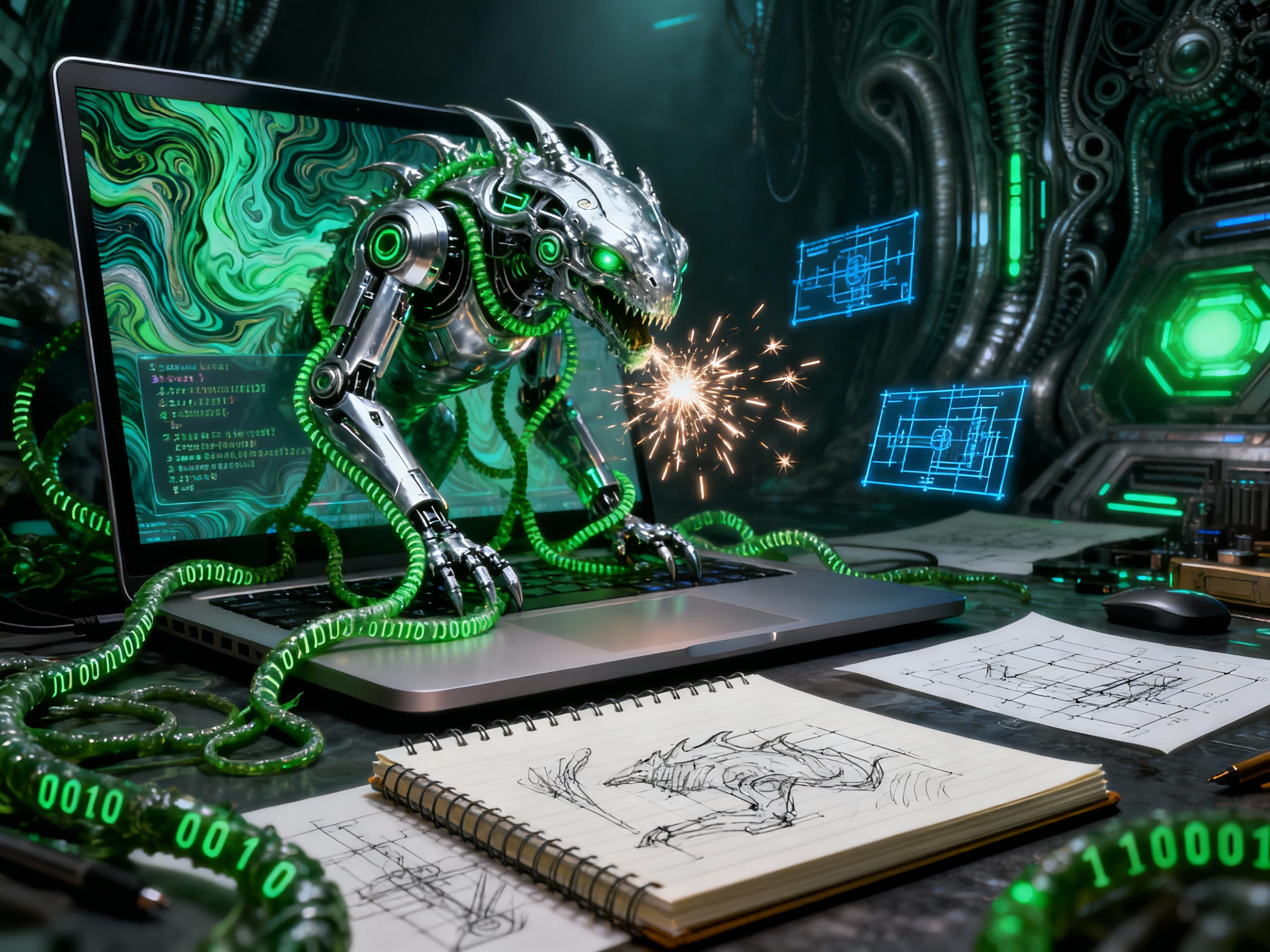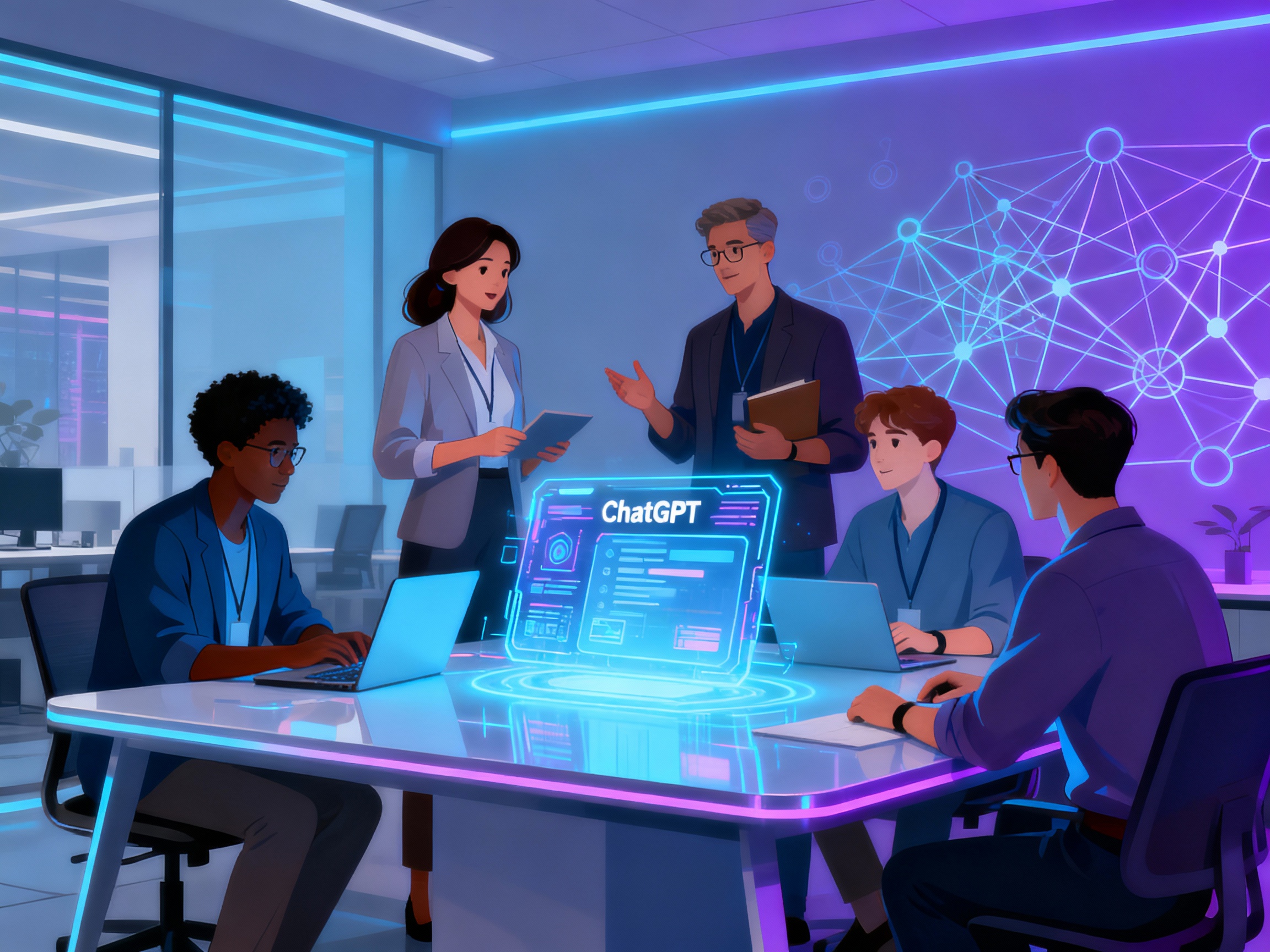Introduction
In 2025, AI like ChatGPT became a part of everyday life. About 600 million people use it every month. It's almost like Facebook. People search for "chat gpt" 21.8 million times a month. These numbers show: AI is not just a toy. It helps at work. Programmers write code faster. Marketers create ads in minutes. Teachers tailor lessons to each student. AI is changing the job market. It increases speed but requires new skills.
In this post, we will analyze the changes step by step. We will use fresh data from 2025. We'll look at numbers, examples, and tips. This will help understand how to adapt. We will talk about programmers, marketing, education, and new skills. At the end - conclusions and an action plan. Let's break it down simply and to the point.
AI does not replace people. It helps. According to a McKinsey report for 2025, 78% of companies already use AI at work. This is 6% more than a year ago. But 47% of managers say: employees lack knowledge. Therefore, it is important to learn. This analysis is based on reports from Stanford, WEF, and others. We will add real stories and forecasts up to 2030.

1. AI and the Programmer Profession
Programmers are the front line. They write code for applications, websites, and systems. AI like GitHub Copilot or Claude helps generate code from a simple description. It's like having a smart assistant. But how does this change work? Let's break it down.
1.1 Scale of Implementation and Numbers
Most developers already use AI. According to a Stack Overflow survey in 2025, 69% of programmers regularly work with ChatGPT. 40% with Copilot. And 76% plan to use AI more. 36% of them learned this in the last year. This speeds up tasks. Stanford research shows: AI solves 72% of simple coding problems. A year ago it was only 4%.
But there are also downsides. For young specialists, work becomes more difficult. According to Stanford data from July 2025, employment among developers aged 22–25 fell by 20%. This is due to the automation of junior tasks. In AI roles, early careers lost 13% of positions. With AI, developers sometimes spend 19% more time checking code. The US Bureau of Labor Statistics predicts: by 2033, the number of developers will grow by 17.9%. This is twice as fast as average.
The benefits are clear. 90% of users save time. But 45% fear layoffs. Experts reassure. Kat Vu from Anthropic says: AI takes routine, leaving people with complex tasks - design, security. Philip Walsh from Gartner adds: more code - more programs. Demand for developers will grow. According to WEF, by 2030 AI will create 170 million jobs, removing 92 million. Net gain - 78 million.
In 2025, demand for AI engineers soared. San Francisco is the center of vacancies. 80% of roles will remain with people. New ones are emerging: prompt engineers, model testers.
1.2 Real Cases and Strategies
Take AstraZeneca. They use AI for medical data. Processing time was reduced by 40%. Employees were not fired. They were transferred to analysis. Microsoft and Amazon use Copilot. A programmer describes an idea - AI writes a draft. Then the person checks. Projects go 126% faster.
In 2025, Amazon cut junior roles but hired for AI integration. Bootcamp students are looking for work in startups or even fast food. Dario Amodei from Anthropic warns: AI can remove half of entry-level jobs in 1–5 years. The strategy is simple. Learn to delegate. AI is like a junior colleague. Explain the task clearly. Check the result. Focus on architecture and security.
1.3 Forecasts and Risks
By 2030, 50% of companies will restructure their business under AI. 80% will teach employees AI skills. Risks: AI generates errors. Without verification - vulnerabilities. Plus ethics: who is responsible for bad code?
Recommendations for programmers:
- Learn prompt engineering. This is the skill of writing precise requests. DataCamp has free lessons. Setting parameters (temperature, length) improves the result.
- Develop criticism. Check every line. Use tools like SonarQube for security.
- Stay on top of trends. Study clouds (AWS), cybersecurity. IBM offers courses on quantum computing.
- Work in a team with AI. Test iteratively. Read Stanford blogs for updates.

2. Marketing and Content: AI as an Advertising Assistant
Marketing is about selling ideas, products, or services. Previously, marketers spent hours writing texts, designing images, or analyzing customer data. Now AI like ChatGPT, Midjourney, or Synthesia does it in minutes. Imagine: you say "create an Instagram post about summer shoes," and AI provides ready text with photo ideas. This changes all the work. Marketing becomes faster, smarter, and more personalized. But there are pitfalls: how to maintain brand uniqueness? Let's break it down step by step.
2.1 Market Scale and Numbers
The AI market in marketing is growing like yeast. In 2025, its volume is $89.85 billion. This is almost twice as much as in 2024 ($36 billion). By 2028, $107.4 billion is expected. According to other estimates, the global AI market as a whole is $391 billion this year, growing to $1.81 trillion by 2030. Why so? Because AI helps sell better. 92% of companies plan to invest in generative AI in the next three years.
How many marketers already use AI? 88% - daily. This is 10% more than in 2024. 78% of organizations use AI in at least one business function. According to a SurveyMonkey survey, 93% use AI to quickly create content. 81% - for data analysis and idea generation. 90% say decisions are made faster. Another 83% note: AI frees up time for strategy. And 81% see sales growth and brand recognition.
But not everything is smooth. 54% of marketers want more training. 43% don't know how to get the most out of the tools. In 2025, 51% use AI for content optimization, 65% for personalization. The market is growing by 26.7% per year. In the US - $19.65 billion only for AI marketing. This means: those who master AI are ahead.
2.2 Changes in Tools and Processes
AI changes how content is created. In 2024–2025, marketers use it for texts (55%), SEO optimization (54%), images (53%), videos (52%), and even audio (22%). The tools are simple: ChatGPT writes posts, Midjourney draws images, Synthesia creates videos with avatars. In a minute - a ready video for YouTube.
Personalization is a key trend. 72% of marketers adapt ads to each client. This improves experience by 70%. AI analyzes data: what a person bought, where they live, what they liked. And suggests: "Discount on coffee for you." In 2025, 73% of business leaders say: AI will restructure personalization.
Efficiency is growing. 68% of companies see a plus in content profitability. 65% improve SEO. 76% rank higher in searches thanks to AI texts. AI saves 3 hours per post or email. New features: automated sales funnels (from ad to purchase), chatbots that respond 24/7. 40% of firms already hire AI specialists. 95% say marketing has become more effective.
In 2025, AI predicts customer needs. For example, if you are looking for clothes, it will suggest size and color in advance. 47% of digital advertising is spent on AI tools. Global spending - $82 billion. This is not fiction: companies like Adobe use AI for entire campaigns.
2.3 Challenges and Risks
Not everything is rosy. 60% of marketers fear brand risks: AI can produce fake or non-original text. 39% don't know how to use it safely. Main problems: data leakage (top-1 fear), lack of data for AI training, and lack of strategy. Plus copyright: whose text if AI generated it? And errors: AI can "invent" facts.
Only 16% believe AI will replace them completely. More often - an assistant: 45% for ideas, 31% for structure, 18% for drafts, 6% for the entire text. Regulators require: label AI content. This increases trust but adds work. In 2025, ethics is key: 73% of businesses see AI as a tool for honest personalization.
2.4 Recommendations for Marketers
- Master tools step by step. Start with ChatGPT for texts, Gemini for ideas, Midjourney for visuals.
- Practice: create 5 posts a week. But always edit - add your brand style.
- Focus on strategy. AI takes routine, you - analysis. Study the audience: what do they want? Use AI for forecasts, but check the data.
- Learn constantly. 54% need courses - enroll in HubSpot or Coursera on AI marketing. It's free or cheap. Read reports like Adobe 2025 AI Trends.
- Create ethics rules. Write a policy: how to store data, label content, avoid bias. Discuss in the team: “What if AI made a mistake?”
- Test on small. Start with email newsletters or social media. Measure: did clicks increase? According to SurveyMonkey, such tests give +20% efficiency.
In the end, marketing with AI is like a tandem: machine speed, human creativity. By 2030, the market will double, so start now.

3. AI in Education: Lessons for Everyone
Education is about knowledge and skills. Previously, lessons were "one size fits all." Now AI makes them personal: for a weak student - simple examples, for a strong one - complex tasks. Platforms like Engageli or Duolingo with AI analyze progress and adapt. Teachers save time, students learn better. But importantly: AI does not replace the teacher, it helps. Let's analyze numbers, examples, and tips.
3.1 Numbers and Trends
The AI market in education is $7.57 billion in 2025. By 2034 - $112.3 billion, with 48% growth in Asia. Other estimates: $8.3 billion this year, up to $29.89 billion by 2029. Personalized learning with AI - $5.96 billion in 2025.
How many use it? 60% of teachers - for lessons and materials. Savings - 44% of preparation time. 86% of schools have implemented AI, 89% of students - ChatGPT for assignments. Personalization increases performance by 30%, tests - by 54%. In engaged classes with AI - 13 times more discussions, scores +54%. Motivation: 75% in personalized courses versus 30% traditional. Attendance +12%, dropouts -15%.
Feedback: AI checks 10 times faster. For adults: 77% of employees are ready to learn AI skills, 92% of bosses invest in training. McKinsey: AI will add $7.9 trillion to the economy. In universities, 57% prioritize AI - 8% more than in 2024.
3.2 Application Examples
AI in education works in practice. Take personalized learning. Platforms like Khan Academy or Duolingo with AI look at a student's mistakes and provide exercises for them. If you confuse verbs in English, AI will offer more examples. This is especially cool in online courses: 75% of students are motivated when lessons are tailored to them.
Automatic checking is another hit. AI like Gradescope evaluates essays or tests in seconds. Feedback comes immediately: "Weak argumentation here, add an example." Teachers spend less time on routine and more on conversations with the class. In schools with such AI, scores increase by 54%.
Material generation: ChatGPT creates lesson plans. Say "Ecology lesson for 7th grade," and you get goals, activities, tests. This speeds up preparation 2–3 times. In corporate training, companies like Google use AI for training: modules tailored to the employee's level. Efficiency +57%.
Multilingualism is a bonus. AI translates and adapts in 47 languages. IBM Watson analyzes feedback from 60 thousand students worldwide and improves courses. Example: in India, the Byju's platform with AI teaches English to children from villages. Attendance +12%, dropouts -15%. In 2025, 89% of students use ChatGPT for assignments, but teachers integrate it: "Use AI, but explain why your answer is better."
Another trend: virtual labs. AI simulates experiments in chemistry or physics without real test tubes. Students in QuEra or Labster conduct thousands of tests online - safely and cheaply.
3.3 Challenges and Ethics
AI is not a panacea. The main problem: data quality. Models learn from old texts and can repeat bias. For example, if the dataset is more about male scientists, AI may ignore women. In evaluation, this is unfair: 20% of systems show bias in tests.
Privacy is second. Schools store student data: grades, answers. Laws like GDPR or FERPA require protection. If AI is in the cloud, hackers can steal. In 2025, 35% of schools are concerned about this. Plus: AI does not teach ethics. Students can copy answers without understanding. 40% of teachers see plagiarism from AI.
The role of the teacher changes, but does not disappear. AI provides facts, but empathy and motivation come from a person. IBM experts: teachers should teach criticism - "Check if this is true from AI?" In 2025, 60% of educators use AI, but 70% want more ethics training.
Another risk: inequality. In poor countries, AI access is weak. Asia grows by 48%, but Africa lags behind. Solution: open platforms like Google Classroom with AI.
3.4 Tips for Education Workers
- Use AI as a tool. For lessons - yes, but always edit.
- Check for accuracy: ask AI “Explain why this is true?”
- Be transparent. Tell students: "This test is from AI, but your analysis is yours". Teach them to check sources.
- Protect data. Choose platforms with GDPR. Do not upload personal without consent. Update passwords and rules.
- Develop skills. Courses on Coursera on "AI in Education" - free. Read Engageli reports.
- Practice: create a lesson with ChatGPT.
- Focus on people. AI speeds up, but conversations and inspiration are yours. Engage the class: "What do you think about this from AI?"
With AI, education becomes more flexible. By 2034, the market will grow 15 times - an opportunity for everyone.

4. New Skills in the AI Era: What to Learn to Stay Ahead
AI changes not only tasks but also what is valued in people. Previously, "technique" was enough. Now you need the ability to work with AI, think critically, and adapt. According to WEF, by 2030, 39% of skills will become obsolete. But AI, data, cybersecurity will grow. Plus soft skills: creativity, leadership. Let's analyze trends, specific skills, and how to boost

Leave a comment
Comment